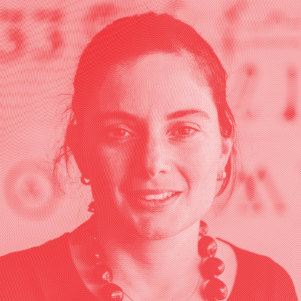I’m a full professor within the School of Engineering and I work in the institutes of microengineering and bioengineering. I run EPFL’s Centre for Neuroprosthetics, which has eight laboratories and is housed on the Biotech Campus in Geneva. I teach and manage a cross-disciplinary research team of 15 people from the fields of engineering, chemistry and life sciences. Our work is focused on designing and developing biomedical devices called neuroprosthetics, which are used to treat neurological traumas and diseases. My work is both very structured and very free.
I’m passionate about combining knowledge in the areas of engineering and life sciences, and the idea of making a device or implant that may one day be useful for people with a neurological impairment. I also love my team and all the technological challenges we deal with together.
My career path. It’s been pretty standard for a university professor : I studied electrical engineering at INSA in Lyon, did a postdoc at Princeton University in the States, and then obtained my first independent research position at Cambridge University, before setting up my own lab at EPFL in 2011 as an assistant professor. Throughout my career, I’ve been supervised and supported by some exceptional mentors. My mentor at Princeton taught me his approach to the job of university professor, guided me in the development of my research programme and helped me to build my own international network of colleagues. I’m still very close to him, and we’re in regular contact.
I wouldn’t be in the position I’m in now without the unfailing support of my parents and my husband. It’s really a team sport ! A few key colleagues also really believed in me and offered me opportunities.
A downside or obstacle ? There are only 24 hours in a day, and so many things to do. Becoming and being a professor requires a lot of time, work, humility and perseverance. One obstacle is time management, and for women there’s also the race against the biological clock. The people around me – both in my home and my work life – have been very positive and encouraging. They’ve always supported me in my career and in the choices I made. The biggest obstacle is believing in yourself.
I’m proud to have been able to combine my family life and my passion for research. It is possible to be a woman, a mother and a professor of science and engineering all at the same time. I’m also proud that I manage my own team and lab and that I’ve helped and trained members of my team so that they can progress in their careers. I’m a pioneer in the field of flexible and extendable electronics and their application in neurotechnologies. My team recently demonstrated that flexible implants integrated better into neuronal tissue than rigid implants. That’s a focus of our work : can we make implants invisible and integrated into biological tissue in the future ? My strong point is that I’m very organized and work with researchers from very different fields, including materials science, electronics, mechanics, neuroscience and neurosurgery.
The Proust Questionnaire
This section is available only in the original language
Au-delà de votre profession
Mes enfants :-) et la musique, je suis flûtiste.
Des personnes qui vous inspirent
Simone Veil
Un livre
Henry V (William Shakespeare)
Un modèle
Mon mentor : le professeur Sigurd Wagner à Princeton.
Un objet
Mon carnet moleskine
Un rêve
Un safari en Afrique



